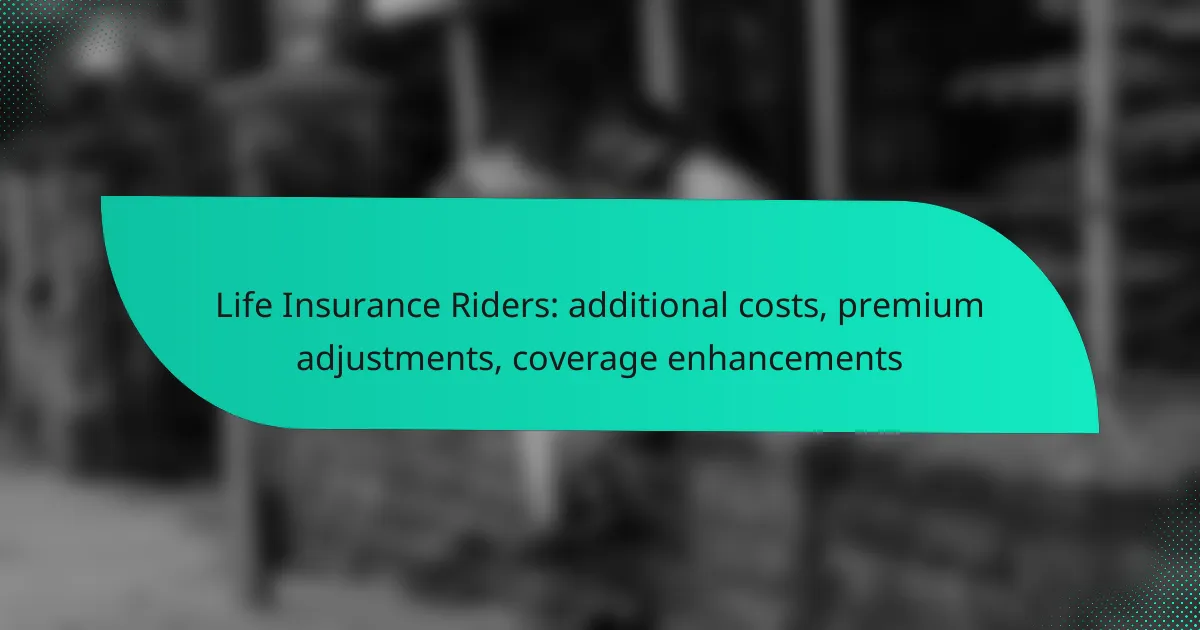Life insurance riders are valuable additions that enhance your policy by offering tailored benefits and options to meet individual needs. While they can incur extra costs and lead to premium adjustments, these riders significantly improve the overall value and flexibility of your coverage.

How do life insurance riders enhance coverage?
Life insurance riders enhance coverage by providing additional benefits or options that can be tailored to individual needs. These riders often come with extra costs but can significantly improve the policy’s value and flexibility.
Accelerated death benefit rider
The accelerated death benefit rider allows policyholders to access a portion of their death benefit while still alive if they are diagnosed with a terminal illness. This can provide financial support for medical expenses or other needs during a difficult time.
Typically, the amount available is a percentage of the total death benefit, often ranging from 25% to 100%. It’s essential to understand the terms, as accessing these funds may reduce the final payout to beneficiaries.
Waiver of premium rider
The waiver of premium rider ensures that if the policyholder becomes disabled and unable to work, their life insurance premiums will be waived for a specified period. This rider helps maintain coverage without the financial burden of premium payments during challenging times.
Most policies require a waiting period, often around six months, before the waiver kicks in. It’s crucial to check the specific conditions and duration of the waiver to ensure it meets your needs.
Child term rider
A child term rider provides life insurance coverage for the policyholder’s children, typically at a low cost. This rider offers peace of mind, knowing that if a child passes away, a death benefit will be paid to help with expenses.
The coverage usually lasts until the child reaches adulthood or a specified age, often around 18 or 21. It’s a cost-effective way to ensure financial protection for your family during a child’s formative years.
Accidental death rider
The accidental death rider pays an additional benefit if the policyholder dies due to an accident. This rider can double or even triple the death benefit, providing extra financial security for loved ones in case of an unexpected tragedy.
It’s important to read the policy details, as certain exclusions may apply, such as deaths resulting from risky activities or pre-existing conditions. Understanding these limitations can help you make informed decisions about this rider.
Long-term care rider
The long-term care rider allows policyholders to access their death benefit to cover long-term care expenses, such as nursing home or in-home care. This rider can be a valuable addition, especially as healthcare costs continue to rise.
Typically, the rider will specify a percentage of the death benefit that can be used for long-term care, often around 2% to 4% per month. Evaluating your potential long-term care needs can help determine if this rider is a wise investment for your future.

What are the additional costs associated with life insurance riders?
Life insurance riders can incur additional costs that affect your overall premium and policy value. These costs may include increased premiums, one-time fees for specific riders, and potential impacts on the policy’s overall value.
Increased premium costs
Adding riders to your life insurance policy typically results in higher premium costs. Each rider enhances coverage, which means insurers will adjust your premium based on the added risk or benefits. For instance, a critical illness rider may increase your monthly premium by a few dollars to several tens of dollars, depending on the coverage amount and your age.
When considering riders, evaluate how much the increased premium fits into your budget. Ensure that the additional cost aligns with the potential benefits you expect to receive.
One-time fees for specific riders
Some life insurance riders may come with one-time fees at the time of policy issuance. These fees can vary widely depending on the rider’s nature and the insurer’s policies. For example, a waiver of premium rider might have a nominal setup fee that is added to your initial premium payment.
Before committing to a rider, ask your insurance agent about any one-time fees associated with it. Understanding these costs upfront can help you make informed decisions about your policy.
Impact on overall policy value
The inclusion of riders can affect the overall value of your life insurance policy. While riders can enhance coverage, they may also reduce the cash value accumulation in permanent life insurance policies. This is particularly relevant for riders that provide additional benefits, such as accelerated death benefits.
Regularly review your policy to understand how riders influence its value. If you find that the riders are not providing sufficient benefits relative to their costs, consider adjusting your coverage or removing unnecessary riders to optimize your policy’s value.

How do premium adjustments work with life insurance riders?
Premium adjustments for life insurance riders occur when additional coverage options are added or modified, impacting the overall cost of the policy. These adjustments can increase or decrease premiums based on the specific riders selected and the insurer’s assessment of risk.
Factors influencing premium changes
Several factors can influence premium changes when adding life insurance riders. The type of rider selected, such as critical illness or accidental death, plays a significant role in determining the cost. Additionally, the insured’s age, health status, and lifestyle choices can affect the premium adjustments, as insurers evaluate the risk associated with each individual.
Another factor is the insurer’s underwriting guidelines, which may vary between companies. Some insurers may offer more competitive rates for certain riders, while others may impose stricter criteria that lead to higher premiums.
Frequency of premium adjustments
Premium adjustments typically occur at the time of policy renewal or when a rider is added or modified. Most insurers review premiums annually, but significant life changes, such as a new health condition or lifestyle change, can prompt a reassessment outside of the regular schedule.
It’s essential to understand that not all riders will lead to immediate premium changes. Some may have a waiting period before affecting the overall cost, while others may adjust premiums only after a claim is made.
Examples of premium adjustment scenarios
For instance, if a policyholder adds a critical illness rider, their premium may increase by a certain percentage, often in the range of 10-30%, depending on the insurer’s risk assessment. Conversely, if a policyholder successfully improves their health, such as quitting smoking, they may qualify for a lower premium upon renewal.
Another example is the addition of an accidental death benefit rider, which could result in a modest premium increase, typically around 5-15%. However, if the policyholder’s health deteriorates, the insurer may adjust the premium upward to reflect the increased risk.

What criteria should you consider when selecting life insurance riders?
When selecting life insurance riders, consider how they align with your personal health needs, family financial obligations, and future financial goals. These factors will help you determine which riders enhance your coverage effectively while managing additional costs.
Personal health needs
Your personal health needs play a crucial role in selecting life insurance riders. If you have specific health concerns or a family history of certain conditions, riders like critical illness or disability income can provide essential financial support during challenging times.
Evaluate your current health status and potential future risks. For instance, if you are at a higher risk for chronic illnesses, a rider that offers accelerated death benefits may be beneficial, allowing you to access funds while still alive if diagnosed with a terminal illness.
Family financial obligations
Consider your family’s financial obligations when choosing life insurance riders. If you are the primary breadwinner, riders that provide additional coverage for accidental death or income replacement can ensure your family’s financial stability in the event of your untimely passing.
Assess your family’s current and future expenses, such as mortgage payments, education costs, and daily living expenses. A rider that enhances your policy’s payout can help cover these obligations, providing peace of mind for you and your loved ones.
Future financial goals
Your future financial goals should influence your choice of life insurance riders. If you plan to save for your children’s education or your retirement, riders that allow for cash value accumulation can be advantageous, offering both protection and an investment component.
Think about how much coverage you will need as your financial situation evolves. Riders that adjust coverage limits or provide options for additional purchases can help you adapt your policy to meet changing needs, ensuring you stay on track with your financial objectives.

How do life insurance riders compare across major providers?
Life insurance riders vary significantly among major providers, impacting coverage options and costs. Understanding these differences can help you choose the best policy for your needs.
State Farm rider options
State Farm offers a variety of riders that enhance life insurance policies, including accidental death, waiver of premium, and children’s term riders. The accidental death rider provides additional benefits if the insured dies due to an accident, while the waiver of premium rider ensures that premiums are waived if the policyholder becomes disabled.
When considering State Farm’s riders, evaluate your specific needs. For instance, if you have children, the children’s term rider can provide additional coverage for a nominal fee. Always review the cost implications, as adding riders can increase your premium significantly.
Prudential rider offerings
Prudential features several riders, such as the accelerated death benefit and the term conversion rider. The accelerated death benefit allows policyholders to access a portion of their death benefit if diagnosed with a terminal illness, providing financial relief during difficult times.
Prudential’s term conversion rider is particularly useful for those who want flexibility, allowing the conversion of a term policy to a permanent one without additional medical underwriting. Be mindful of the premium adjustments that may occur when adding these riders, as they can vary based on age and health status.
MetLife rider features
MetLife provides riders like the critical illness rider and the long-term care rider. The critical illness rider pays a lump sum if the insured is diagnosed with a specified critical condition, which can help cover medical expenses or lost income.
The long-term care rider is designed for those concerned about future healthcare needs, offering benefits to cover long-term care services. As with other providers, assess the additional costs associated with these riders, as they can significantly affect your overall premium. Always read the fine print to understand the specific terms and conditions of each rider.

What are the emerging trends in life insurance riders?
Emerging trends in life insurance riders include increased customization options, a focus on wellness benefits, and the integration of technology. These trends allow policyholders to tailor their coverage to better fit their individual needs and lifestyles.
Customization of riders
Customization of life insurance riders is becoming increasingly popular, allowing policyholders to select specific benefits that align with their personal circumstances. Options may include riders for critical illness, disability income, or long-term care, enabling individuals to enhance their coverage based on their unique health and financial situations.
For example, a critical illness rider can provide a lump sum payment if the insured is diagnosed with a serious condition, which can help cover medical expenses or lost income. This flexibility often comes with an additional premium, so it’s essential to evaluate the cost versus the potential benefits.
Focus on wellness benefits
Life insurance policies are increasingly incorporating wellness benefits as riders, encouraging healthier lifestyles among policyholders. These benefits may include discounts on gym memberships, access to health coaching, or rewards for regular health check-ups.
Insurers recognize that healthier individuals may pose lower risks, and thus, integrating wellness initiatives can lead to reduced premiums. For instance, a policyholder who maintains a healthy lifestyle might receive a premium discount of up to 10-15% annually.
Integration of technology
The integration of technology in life insurance riders is transforming how policies are managed and utilized. Insurers are leveraging mobile apps and online platforms to provide policyholders with real-time access to their coverage details and rider options.
Moreover, telemedicine services are being offered as riders, allowing policyholders to consult healthcare professionals remotely. This can be particularly beneficial in reducing healthcare costs and improving access to care, making it a valuable addition to modern life insurance policies.
